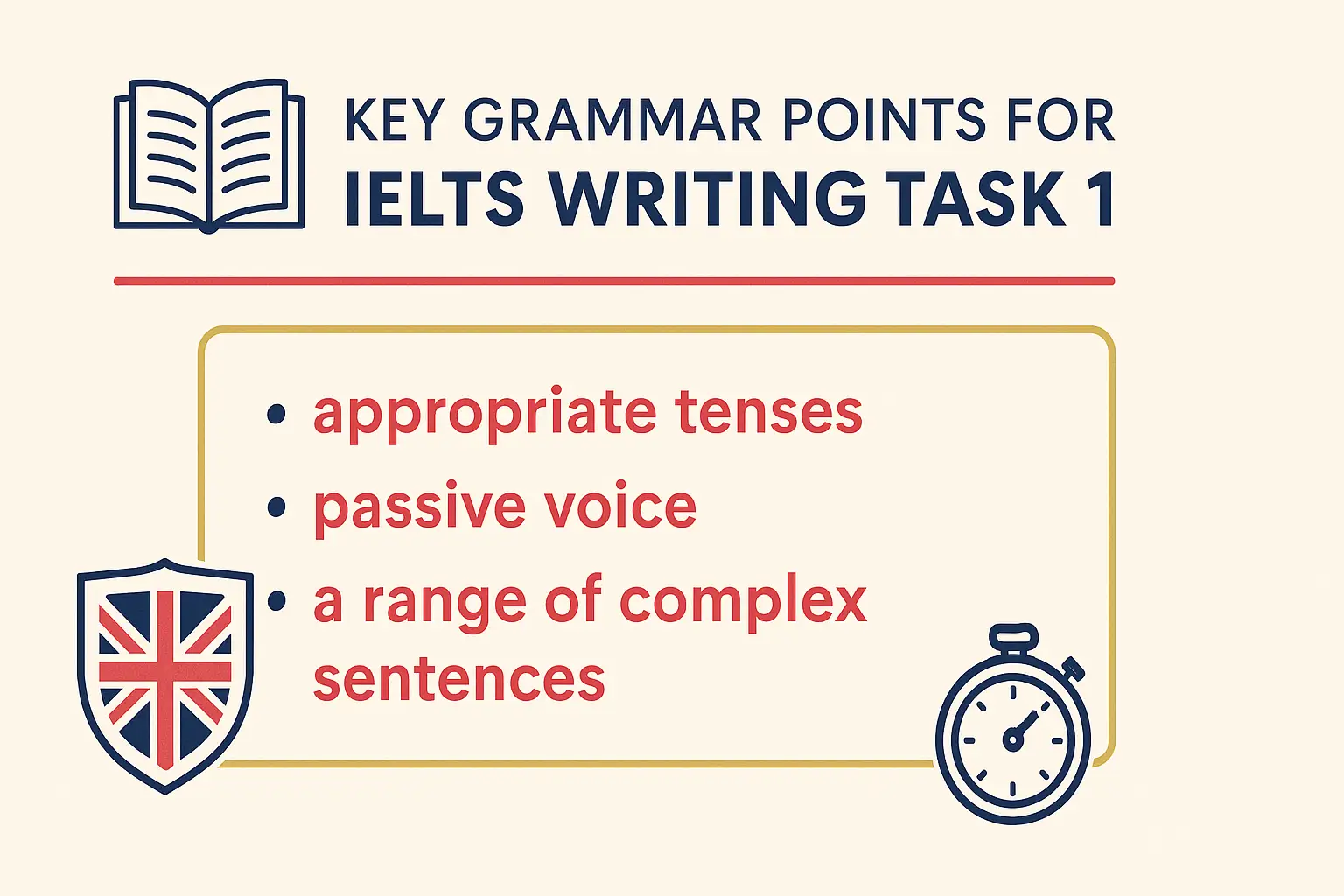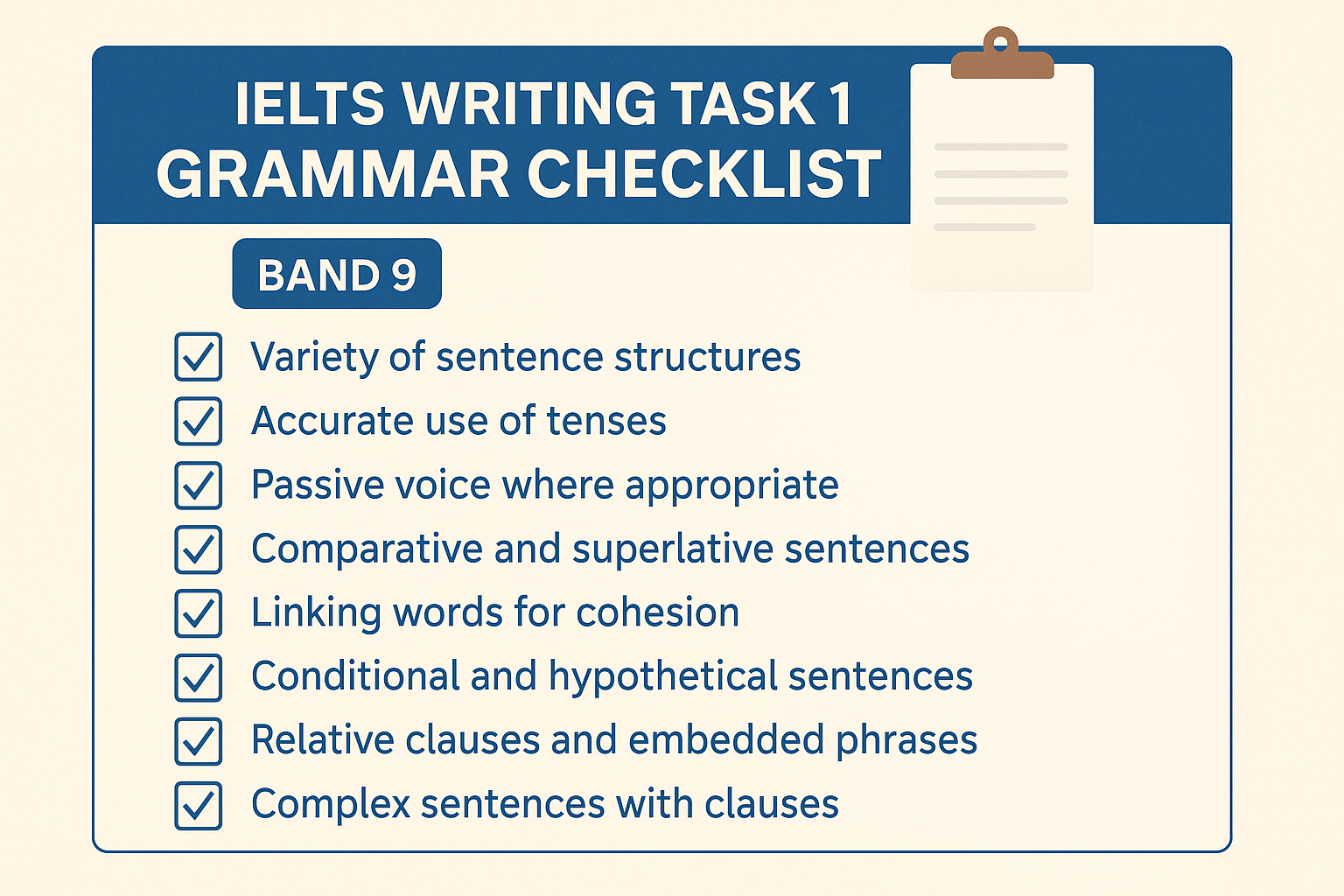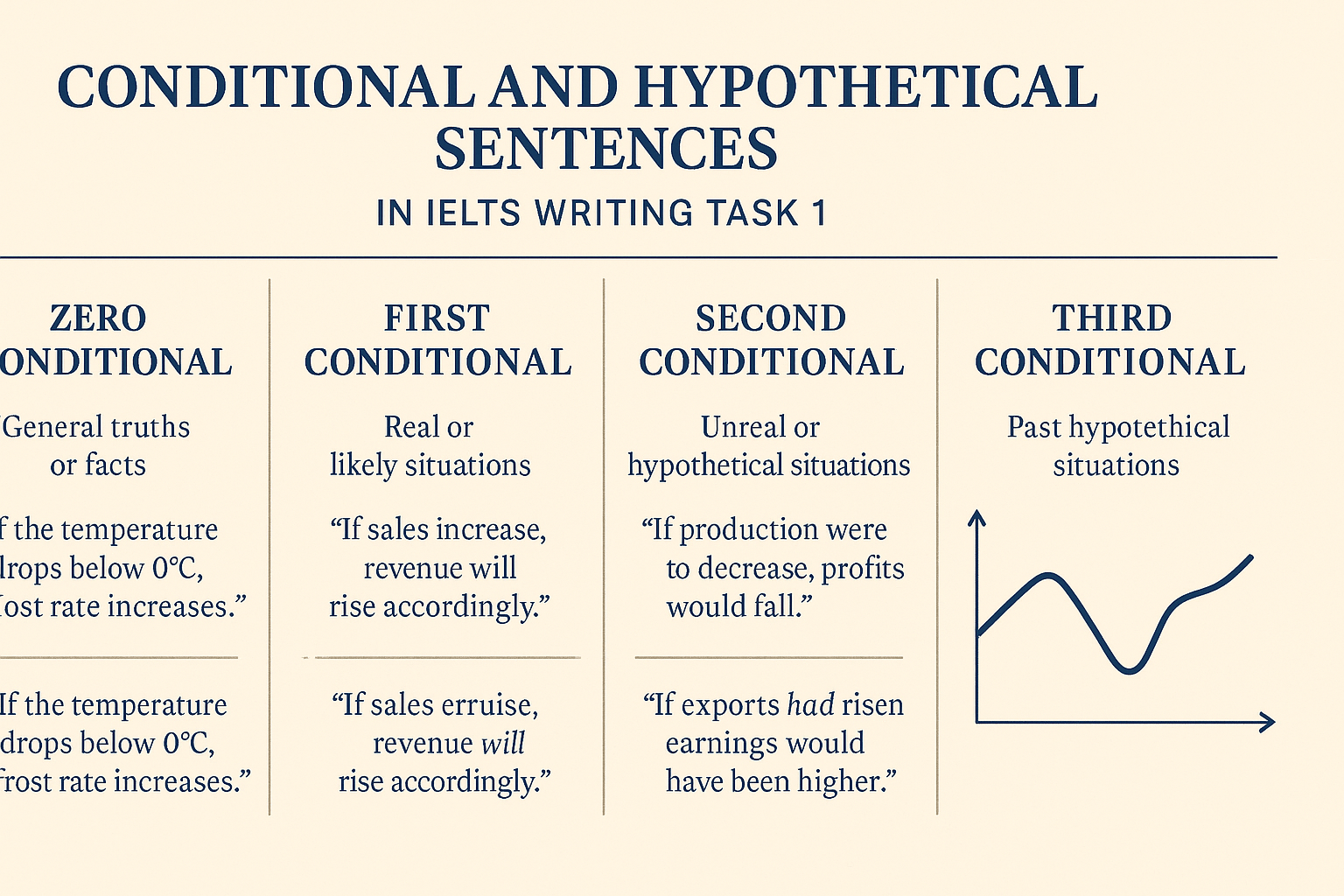- Why Focus on Grammar in IELTS Writing Task 1?
- Essential Tenses for IELTS Writing Task 1 Grammar
- Sentence Variety: Why and How to Use It
- Mastering the Passive Voice in IELTS Writing Task 1 Grammar
- Practical Tips to Improve Your IELTS Writing Task 1 Grammar Accuracy
- Example Paragraph Using Strong IELTS Writing Task 1 Grammar
- Internal and External Resources to Support Your Study
- Final Thoughts
When preparing for IELTS Writing Task 1, mastering grammar is essential to achieve a Band 7 or higher. As an IELTS instructor who has helped countless students improve their writing, I understand that grammar isn’t just about avoiding mistakes — it’s about using the right structures to clearly and accurately describe data. In this post, I’ll guide you through the key grammar points you need to know for IELTS Writing Task 1, including tenses, sentence variety, passive voice, and accuracy tips that can boost your score.
If you want to learn more about IELTS and official guidelines, you can visit the IELTS official website, or check out resources from the British Council and IDP IELTS.
Why Focus on Grammar in IELTS Writing Task 1?
Grammar is one of the four criteria that IELTS examiners use to assess your writing. Using a range of correct grammatical structures accurately shows your language proficiency and ability to convey complex information effectively. Without strong grammar, your report risks being unclear or repetitive, which lowers your score.
This post covers:
-
The essential tenses you’ll use in Task 1 reports
-
Sentence types and variety for clarity and interest
-
Using passive voice correctly
-
Practical tips to improve grammatical accuracy
If you haven’t already, I highly recommend checking out my complete guide to IELTS Writing Task 1 Vocabulary to complement your grammar skills with high-impact words and phrases that will make your descriptions even stronger.
Essential Tenses for IELTS Writing Task 1 Grammar
One of the most common questions students ask is: What tenses should I use for IELTS Writing Task 1? The answer depends on the type of data you’re describing. Here’s a simple breakdown:
Present Simple Tense
Use the present simple to describe general facts, current states, or permanent situations. This is common when describing charts or diagrams showing data that is generally true.
Example:
The bar chart shows the number of students enrolled in five different courses.
Past Simple Tense
Use the past simple when describing data from a completed period in the past, such as historical trends or data from a specific past year.
Example:
The line graph illustrated a steady increase in sales from 2010 to 2015.
Present Perfect Tense
Present perfect is useful when discussing trends or changes that started in the past and continue to the present.
Example:
The population has increased steadily over the last decade.
Future Tenses
When predictions or future projections are included in the chart or task, use the future simple or “will” form.
Example:
The graph predicts that electricity consumption will double by 2030.
Sentence Variety: Why and How to Use It
Examiners look for a variety of sentence types to demonstrate your language skills. Using only simple sentences can make your writing seem basic and repetitive, which affects your band score negatively.
Simple Sentences
Contain one independent clause. Use them for straightforward facts.
Example:
The number of cars increased.
Compound Sentences
Use coordinating conjunctions (and, but, or) to combine two independent clauses.
Example:
Car sales increased, but motorcycle sales remained stable.
Complex Sentences
Contain one independent clause and at least one dependent clause (using words like although, since, which).
Example:
Although car sales increased, motorcycle sales remained stable.
By mixing simple, compound, and complex sentences, you make your report more engaging and demonstrate grammatical control.
Mastering the Passive Voice in IELTS Writing Task 1 Grammar
Passive voice is a key feature in IELTS Writing Task 1 because the focus is often on the data or process, not who is performing the action.
Why Use Passive?
-
It creates a formal tone appropriate for academic writing.
-
It emphasizes the information or data rather than the agent.
When to Use Passive
Use passive voice especially in process descriptions or when the agent is unknown or unimportant.
Example:
The data were collected over five years.
The process involves several stages.
Avoid Overusing Passive
While passive voice is important, avoid overusing it to keep your writing natural. Balance it with active sentences.
Practical Tips to Improve Your IELTS Writing Task 1 Grammar Accuracy
Grammar accuracy means avoiding common errors that could reduce your score. Here are my top tips:
-
Check subject-verb agreement carefully
Make sure singular subjects have singular verbs and plural subjects have plural verbs. -
Use consistent tenses
If describing a past trend, avoid suddenly switching to present tense unless it fits the context. -
Master articles and prepositions
Many students struggle with “the,” “a,” and prepositions like “in,” “on,” “at.” Practice these carefully. -
Use linking words correctly
Use phrases like “in contrast,” “as a result,” and “compared to” to connect ideas clearly. -
Proofread for simple errors
After writing, check for common grammar mistakes like missing “s,” incorrect verb forms, or sentence fragments.
Example Paragraph Using Strong IELTS Writing Task 1 Grammar
Here’s a sample paragraph illustrating correct grammar usage for Band 7–9:
The line graph illustrates the population growth in three cities between 1990 and 2020. City A’s population increased steadily throughout the period, rising from 1 million to 3 million. In contrast, City B experienced a sharp decline after 2000, while City C’s population remained relatively stable. Overall, the data show significant demographic changes, with City A becoming the most populous.
Notice the mix of present simple (“illustrates”), past simple (“increased,” “experienced”), and comparative phrases (“in contrast,” “overall”) — all of which help clarify the data effectively.
Internal and External Resources to Support Your Study
-
Visit the IELTS official website for detailed test information.
-
Explore practice materials from the British Council and IDP IELTS.
-
Combine this grammar guide with my comprehensive IELTS Writing Task 1 Vocabulary complete guide to maximize your score with strong vocabulary and grammar skills.
Final Thoughts
Improving your IELTS writing task 1 grammar is absolutely achievable with focused practice on tenses, sentence variety, passive voice, and accuracy. Remember, the goal is clear, precise, and formal description of data. Use the tips in this post as a solid foundation, and combine them with targeted practice to reach Band 7 and above.
If you want, I can also help you with follow-up posts on common grammar mistakes, tenses in detail, and sentence structures tailored specifically for Writing Task 1.
Good luck, and keep practicing! Your hard work will pay off.





11 Responses
helloI really like your writing so a lot share we keep up a correspondence extra approximately your post on AOL I need an expert in this house to unravel my problem May be that is you Taking a look ahead to see you
I loved as much as youll receive carried out right here The sketch is tasteful your authored material stylish nonetheless you command get bought an nervousness over that you wish be delivering the following unwell unquestionably come more formerly again since exactly the same nearly a lot often inside case you shield this hike